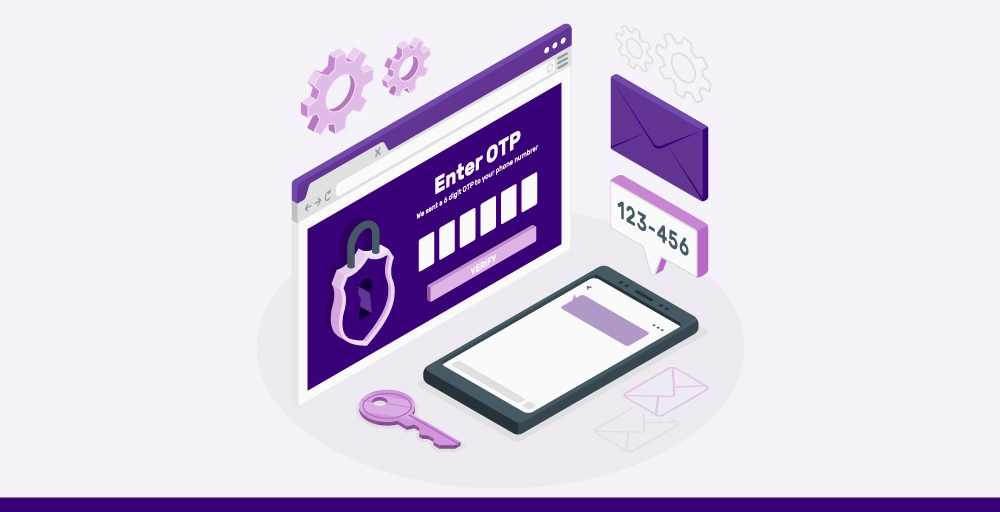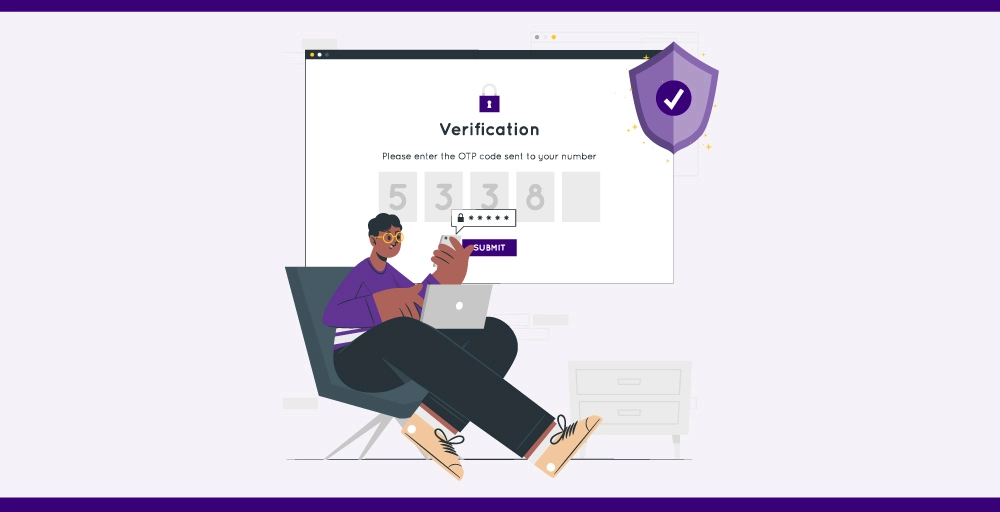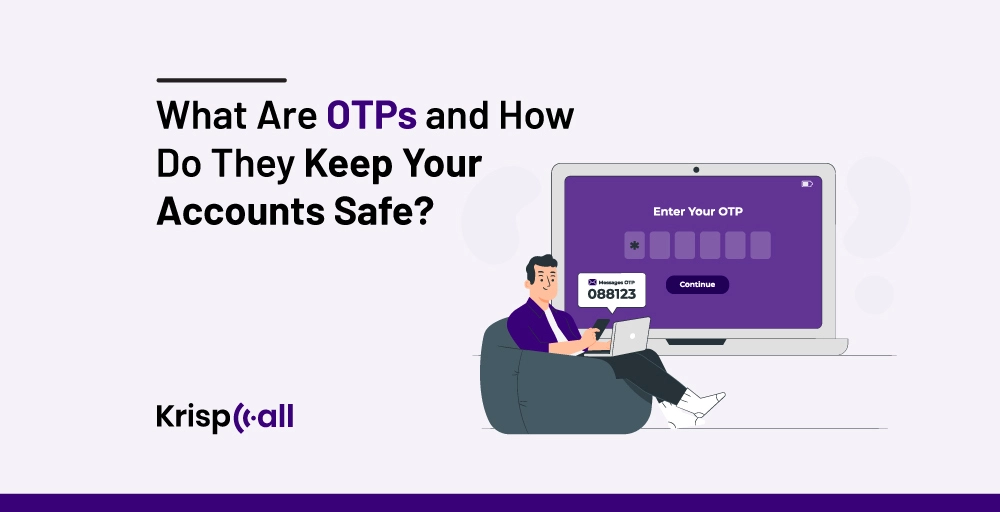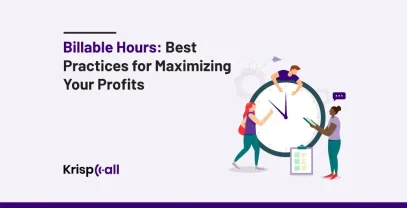In the world of cybersecurity 🐱💻 , one-time password OTPs are essential safeguards against cybercrime. The unique codes are generated for single use and are typically sent to a user’s phone number or email address during login attempts or transactions.
OTPs have become the main strength 💪 of security in the modern world. Also known as one-time passcodes, they are widely employed to safeguard sensitive data.
In this article, we will explore OTPs, why they are safe, and how they work, including different types of OTP platforms.
🔑 Key Highlights
- OTPs are 4 to 6-digit codes sent to your phone or email for login attempts.
- Each code can only be used once, enhancing security for logins and transactions.
- OTPs make it harder for hackers to gain unauthorized access or steal data.
- Various types of OTPs, including SMS, Email, WhatsApp, and many more.
- It is essential for strengthening security in apps and websites, especially in financial services and tech companies.
What are OTPs?
OTPs, aka One Time Passwords, are 4 to 6-digit security codes sent to your phone or email when you sign up or log in to certain websites or apps. They’re random numeric or alphanumeric characters you use to prove it’s you while doing something important online.

OTPs, also known as one-time passwords, are an identity verification tool used to authenticate users logging into an account, network, or system.
The OTP code can only used at once. In other words, each code is only valid for one time you log in. Once you use it, it can’t be used again.
One-time passwords example
Let’s say you’re logging into your online banking account. After entering your username and password, the website generates OTP. You’ve previously set up your account to receive OTPs via SMS.
You receive a text message on your phone containing a unique code, such as “123456“. This code is your OTP, and it’s only valid for a short period, typically a few minutes.
You quickly enter the OTP into the website, and upon successful verification, you gain access to your account. Once used, the OTP becomes invalid and cannot be used again.
In this example, the OTP serves as an additional layer of security beyond your username and password. Even if someone were to steal your login credentials, they would still need the OTP sent to your phone to access your account, making it much harder for unauthorized users to gain entry.
Why is an OTPs safe?
Using one-time passcode codes makes websites and apps safer because they give an additional layer of security. Each time you log in, the OTP changes, making it very hard for anyone to intercept. They make it tougher for hackers to break into accounts without permission. OTPs are also used to protect important data, like financial information.
Some of the important points why OTPs are safe:
- Single-use
- Low Risk of Replay Attacks and Phishing attacks
- Second Factor of Authentication
- Dynamic Code Generation
How do OTPs work?
When you try to sign in to a website or app that uses OTPs. You will need to enter your username and password after that, you will get an OTP code on your mobile.
Here are the simple steps on how OTP works:
- Websites and apps send verification requests when you log in or sign up.
- The back-end server generates codes that are sent to your phone or email.
- You get the code and type it into the app or website.
- If the code is correct, you will have access
What are the benefits of one-time passwords (OTPs)?
Due to the massive use of phones, OTPs are highly flexible. You can get them in different easy ways, which makes them simple and convenient for everyone to use. Due to OTPs, you do not have to stress about your passwords. It reduced the risk of credential theft.
These OTPs are often delivered through out-of-band channels such as SMS, email, or authentication apps, which increases security.
Another big advantage is that OTPs become useless in a minute if you fail to enter at the right time.
Some of the benefits of using one-time passwords (OTPs) are:
- OTPs are more secure than passwords
- OTPs are very easy to use
- Reduced Risk of Phishing
- Protection against hackers
What are the different types of OTPs?
There are various types of OTPs depending on the service you choose. These are the most common types of OTPs
1. SMS
SMS is one of the best ways to send OTPs. SMS are sent to the registered number, so they are very safe to use. Users receive a unique code through SMS, which they then use to prove their identity and complete the authentication process.
2. Email
Email is also the same process, it also sent to the user’s registered email address and can be sent via email inbox on mobile or desktop. This flexibility allows user to authenticate their user’s identity from wherever they are.
3. Token
Users install a software application on their mobile device or computer that generates one-time passwords as a Token. These passwords are typically time-based and change every few seconds.
4. Whatsapp
WhatsApp OTPs are sent through the WhatsApp messaging app. The reason developers and users everywhere love them is that sending texts to different countries is no longer a problem.
5. Authentication Apps
Authentication apps are software applications installed on a user’s specific device that generate one-time passwords (OTPs) for authentication. These apps use algorithms to create unique codes, which users enter along with their regular credentials to access accounts or services.
How are OTPs different from traditional passwords?
One-time passwords differ from traditional passwords in many ways like security, usage, delivery, and many more. Let’s explore some of the important points one by one.
- Strong security: OTPs provide an additional layer of security compared to traditional passwords. Since they are valid for only a short period or a single use, they significantly reduce the risk of unauthorized access, even if intercepted. It cannot be predicated furthermore, it’s impossible to guess the next passcode based on previous ones.
- Usage: Regular passwords are those you remember and type in whenever you need to log in. But with OTPs, instead of remembering them, an app or device often sends them to you whenever you want to log in.
- Convenience: Regular passwords can be hard to remember because they’re long and complicated. But OTPs are usually simpler and easier because they’re sent to you automatically through texts or special apps.
- Automatically fillable: Some apps on Android or iOS devices can automatically fill in OTPs for you, which means you don’t have to leave the app you’re using to enter the code.
- Easy accessible: OTPs are simple to remember because they are typically expressed as 6 or 8-digit codes. Additionally, they are usually visible to the user in a readable email or text message.
What are TOTPs?
TOTPs is a time-based, one-time password algorithm that generates a unique password for each login attempt. It is more advanced than OTPs. TOTPs expire after a short period, such as 30 to 60 seconds.
It works like a clock and creates a new password every set period, which solves problems that have bothered traditional methods for a long time, making TOTP both convenient and safe.
One-time passwords sent through text messages or email might not arrive on time at all because of delays or problems with the network. This is where TOTP helps. It sidesteps the problems with regular passwords by making special one-time codes. Because it counts time, it can make these codes even without the internet. And it’s cheap because you only need to get an app on your phone for it.
OTP and TOTP vs Static Password
Static passwords are traditional but vulnerable to various attacks due to their constant nature and users’ tendencies to choose weak or reused passwords.
One-time passwords (OTPs) offer a higher level of security by providing passwords valid for single sessions or transactions, though they can still be intercepted or tricked through phishing.

Time-based one-time passwords (TOTPs) further enhance security by generating passwords based on a shared secret and current time, significantly reducing vulnerability to interception or phishing attacks and making them the preferred choice for many two-factor authentication systems.
Essential Insight
These days OTPs play a crucial role who want to strengthen the security of their app and websites. Many financial services, banks, and tech companies use OTPs to make more secure access for customers.
OTPs are available in various forms, such as SMS, email, and authentication apps, catering to different user preferences and security needs. Static passwords are at risk in every attack due to their constant nature and tendencies.
Time-based OTPs (TOTPs) further improve security by generating unique passwords for each login attempt. Overall, OTPs are better than traditional passwords due to their modern security and usage.
FAQ
What are OTP used for?
OTP (One-time password) is used to verify the identification during the authentication process. OTP verification provides an additional security layer, which makes it more secure than regular passwords. It helps to stop cyber crimes because OTPs only work for a short time, usually just a few minutes.
What are the different types of OTPs?
There are multiple types of OTPs, including SMS, email, time-based OTPs (TOTPS), Event-based, WhatsApp, and many more.
How to get a one-time password?
To get the one-time password you need to log in sign up on the website or apps, and then the one-time password sent through the sms or email depending upon the service you choose.
How does OTP security guard against phishing attacks?
OTP security helps guard against phishing attacks by providing a dynamic code that is valid for only one login session or transaction. This makes it significantly harder for attackers to gain unauthorized access to accounts, even if they manage to obtain the user’s password through phishing.
What role does pseudorandomness play in OTP generation?
Pseudorandomness refers to the generation of seemingly random OTPs using algorithms that produce unpredictable sequences of characters. This ensures that each OTP is unique and difficult for attackers to predict or reproduce.





